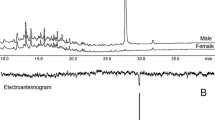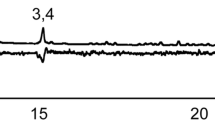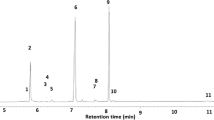Abstract
Edessa meditabunda is a secondary pest within the piercing-sucking stink bug complex that attacks soybean crops in Brazil. The behavioral responses of males and females to aeration extracts from conspecifics suggested the presence of a male-produced sex pheromone. Gas chromatographic (GC) analysis of male and female aeration extracts revealed the presence of two male-specific compounds in a ratio of 92:8. Gas chromatographic -electroantennographic detection (GC-EAD) assays indicated that the major component is bioactive for females, supporting the behavioral data. Analysis of the mass and infrared spectra of the male-specific compounds suggested that they were both methyl-branched long-chain methyl esters. On the basis of the mass spectra of the respective hydrocarbons obtained by micro derivatizations, the structures of these methyl esters were proposed to be methyl 4,8,12-trimethylpentadecanoate (major) and methyl 4,8,12-trimethyltetradecanoate (minor). An 11 step synthetic route that was based on a sequence of Grignard reactions, starting from cyclopropyl methyl ketone, was developed to obtain synthetic standards with a 7.9 % overall yield for the major compound and a 9.9 % yield for the minor. The synthetic standards co-eluted with the natural pheromones on three different GC stationary phases. Y-tube olfactometer assays showed that the synthetic standards, including the major compound alone and a mixture of the major and minor compounds in the proportion found in natural extracts, were strongly attractive to females.









Similar content being viewed by others
References
Aldrich, J. R., Kochansky, J. P., and Abrams, C. B. 1984. Attractant for a beneficial insect and its parasitoids: pheromone of the predatory spined soldier bug, Podisus maculiventris (Hemiptera: Pentatomidae). Environ. Entomol. 13:1031–1036.
Aldrich, J. R., Oliver, J. E., Lusby, W. R., Kochhar, T. S., and Lockwood, J. A. 1987. Pheromone strains of the cosmopolitan pest, Nezara viridula (Heteroptera: Pentatomidae). J. Exp. Zool. 244:171–175.
Aldrich, J. R., Lusby, W. R., Marron, B. E., Nicolaou, K. C., Hoffmann, M. P., and Wilson, L. T. 1989. Pheromone blends of green stink bugs and possible parasitoid selection. Naturwissenschaften 76:173–175.
Aldrich, J. R., Hoffmann, M. P., Kochansky, J. P., Lusby, W. R., Eger, J. E., and Payne, J. A. 1991. Identification and attractiveness of a major pheromone component for Nearctic Euschistus spp. stink bugs (Heteroptera: Pentatomidae). Environ. Entomol. 20:477–483.
Aldrich, J. R., Oliver, J. E., Lusby, W. R., Kochansky, J. P., and Borges, M. 1994. Identification of male-specific volatiles from Nearctic and Neotropical stink bugs (Heteroptera: Pentatomidae). J. Chem. Ecol. 20:1103–1111.
Aldrich, J. R. 1995. Chemical communication in the true bugs and parasitoid exploitation, pp. 318–363, in R. T. Cardé and W. J. Bell (eds.), Chemical Ecology of Insects. Chapman & Hall, New York.
Ambrogi, B., Cortés, A., and Zarbin, P. H. G. 2012. Identification of Male-Produced Aggregation Pheromone of the Curculionid Beetle Sternechus subsignatus. J. Chem. Ecol. 38:272–277.
Attygalle, A. B. 1998. Microchemical Techniques, pp. 207–294, in J. G. Millar and K. F. Haynes (eds.), Methods in Chemical Ecology. Chapman & Hall, New York.
Ayres, M., Ayres, M. J., Ayres, D. L., and Santos, A. S. 2003. BioEstat3.0, Aplicações estatísticas nas áreas das ciências biológicas e médicas. Sociedade Civil Mamirauá, Belém.
Biernacki, W. and Gdula, A. 1979. Modification of the method of Julia for the preparation of homoallylic bromides and iodides. Synthesis 1979:37–38.
Borges, M., Jepson, P. C., and Howse, P. E. 1987. Long-range mate location and close-range courtship behaviour of the green stink bug, Nezara viridula and its mediation by sex pheromones. Entomol. Exp. Appl. 44:205–212.
Borges, M. and Aldrich, J. R. 1992. Instar-specific defensive secretions of stink bugs (Heteroptera: Pentatomidae). Experientia 48:893–896.
Borges, M. and Aldrich, J. R. 1994. Attractant pheromone for Nearctic stink bug, Euschistus obscurus (Heteroptera: Pentatomidae): insight into a Neotropical relative. J. Chem. Ecol. 20:1095–1102.
Borges, M., Mori, K., Costa, M. L. M., and Sujii, E. R. 1998. Behavioural evidence of methyl-2,6,10-trimethyltridecanoate as a sex pheromone of Euschistus heros (Het., Pentatomidae). J. Appl. Entomol. 122:335–338.
Borges, M., Zarbin, P. H. G., Ferreira, J. T. B., and da Costa, M. L. M. 1999. Pheromone sharing: Blends based on the same compounds for Euschistus heros and Piezodorus guildinii. J. Chem. Ecol. 25:629–634.
Borges, M., Millar, J. G., Laumann, R. A., and Moraes, M. C. B. 2007. A male-produced sex pheromone from the neotropical redbanded stink bug, Piezodorus guildinii (W.). J. Chem. Ecol. 33:1235–1248.
Çokl, A. 2008. Stink bug interaction with host plants during communication. J. Insect. Physiol. 54:1113–1124.
CONAB 2011. Brasilian Crop Assessment: grains: Tenth Assessment, July 2011. National Supply Company, Brasília.
Corrêa-Ferreira, B. S. and Moscardi, F. 1996. Biological control of soybean stink bugs by inoculative releases of Trissolcus basalis. Entomol. Exp. Appl. 79:1–7.
CORRÊA-FERREIRA, B. S. and PANIZZI, A. R. 1999. Percevejos da soja e seu manejo. EMBRAPA-CNPSo, Circular técnica no. 24, 45 p.
Fish, J. and Alcock, J. 1973. The behavior of Chlorochroa ligata (Say) and Cosmopepla bimaculata (Thomas), (Hemiptera: Pentatomidae). Entomol. News 84:262–268.
Furniss, B. S., Hannaford, A. J., Smith, P. W. G., and Tatchell, R. A. 1989. Vogel's Textbook of Practical Organic Chemistry. Longman Scientific & Tecnical, London.
Harris, V. E. and Todd, J. W. 1980a. Temporal and numerical patterns of reproductive behavior in the southern green stink bug, Nezara viridula (Hemiptera: Pentatomidae). Entomol. Exp. Appl. 27:105–116.
Harris, V. E. and Todd, J. W. 1980b. Male-mediated aggregation of male, female and 5th instar southern green stink bugs and concomitant attraction of a tachinid parasitoid, Trichopoda pennipes. Entomol. Exp. Appl. 27:117–126.
Herbert, J. J. and Toews, M. D. 2011. Seasonal Abundance and Population Structure of Brown Stink Bug (Hemiptera: Pentatomidae) in Farmscapes Containing Corn, Cotton, Peanut, and Soybean. Ann. Entomol. Soc. Am. 104:909–918.
Ho, H.-Y. and Millar, J. G. 2001a. Compounds in metathoracic glands of adults and dorsal abdominal glands of nymphs of the stink bugs, Chlorochroa uhleri, C. sayi, and C. ligata (Hemiptera: Pentatomidae). Zool. Stud. 40:193–198.
Ho, H.-Y. and Millar, J. G. 2001b. Identification and Synthesis of a Male-Produced Sex Pheromone from the Stink Bug Chlorochroa sayi. J. Chem. Ecol. 27:1177–1201.
Ho, H.-Y., Hsu, Y.-C., Chuang, Y.-C., and Chow, Y.-S. 2005. Effect of rearing conditions on production of sternal gland secretion, and identification of minor components in the sternal gland secretion of the predatory stink bug Eocanthecona furcellata. J. Chem. Ecol. 31:29–37.
Ho, H. Y. and Millar, J. G. 2001c. Identification and synthesis of male-produced sex pheromone components of the stink bugs Chlorochroa ligata and Chlorochroa uhleri. J. Chem. Ecol. 27:2067–2095.
Howard, J. J. and Wiemer, D. F. 1983. The defensive secretion of Edessa rufomarginata. Naturwissenschaften 70:202–203.
Krupke, C. H., Brunner, J. F., Doerr, D. D., and Kahn, A. D. 2001. Field Attraction of the Stink Bug Euschistus conspersus (Hemiptera: Pentatomidae) to Synthetic Pheromone-Baited Host Plants. J. Econ. Entomol. 94:1500–1505.
Larock, R. C. 1974. Mercuty on organic-cemistry.V. Direct esterification of alkyl-halides. J. Org. Chem. 39:3721–3727.
Leal, W. S., Kuwahara, S., Shi, X., Higuchi, H., Marino, C. E. B., Ono, M., and Meinwald, J. 1998. Male-released sex pheromone of the stink bug Piezodorus hybneri. J. Chem Ecol. 24:1817–1829.
Lourenção, A. L., Pereira, J. C. V. N. A., Miranda, M. A. C. D., and Ambrosano, G. M. B. 1999. Danos de percevejos e de lagartas em cultivares e linhagens de soja de ciclos médio e semi-tardio. An. Soc. Entomol. Brasil 28:157–167.
Lubeck, A. J. and Sutton, D. L. 1983. Kovats retention indexes of selected hydrocarbons through C10 on bonded phase fused-silica capillaries. J. High Res. Chromatog. 6:328–332.
McBrien, H. L., Millar, J. G., Gottlieb, L., Chen, X., and Rice, R. E. 2001. Male-produced sex attractant pheromone of the green stink bug, Acrosternum hilare (Say). J. Chem. Ecol. 27:1821–1839.
Millar, J. G. 1997. Methyl (2E,4Z,6Z)-deca-2,4,6-trienoate, a thermally unstable, sex-specific compound from the stink bug Thyanta pallidovirens. Tetrahedron Lett. 38:7971–7972.
Moraes, M. C. B., Pareja, M., Laumann, R. A., and Borges, M. 2008. The chemical volatiles (Semiochemicals) produced by neotropical stink bugs (Hemiptera: Pentatomidae). Neotrop. Entomol. 37:489–505.
MORI, K. and MURATA, N. 1994. Pheromone synthesis, CLXII. Synthesis of methyl 2,6,10-trimethyltridecanoate, the male-produced pheromone of the stink bugs, Euschistus heros and E. obscurus, as a stereoisomeric mixture. Liebig's Ann. Chem.:637-639.
Panizzi, A. R. and Slansky, J. 1985. Review of phytophagous pentatomids (Hemiptera: Pentatomidae) associated with soybean in the Americas. Florida Entomol. 68:184–214.
Powell, W. 1999. Parasitoid hosts, pp. 405–427, in J. Hardie and A. K. Minks (eds.), Pheromones of non-lepidopteran insects associated with agricultural plants. CABI Publishing, Wallingford, United Kingdom.
Silva, C. C. A., Laumann, R. A., Ferreira, J. B. C., Moraes, M. C. B., Borges, M., and Çokl, A. 2012. Reproductive Biology, Mating Behavior, and Vibratory Communication of the Brown-Winged Stink Bug, Edessa meditabunda (Fabr.) (Heteroptera: Pentatomidae). Psyche 2012:1–9.
Silva, E. J. E. E., Fernandes, J. A. M., and Grazia, J. 2006. Caracterização do grupo Edessa rufomarginata e descrição de sete novas espécies (Heteroptera, Pentatomidae, Edessinae). Iheringia. Série Zoologia 96:345–362.
Silverstein, R. M., Webster, F. X., and Kiemle, D. J. 2005. Spectrometric Identification of Organic Compounds. John Wiley & Sons, New York.
Souza, B. H. S. 2007. Ocorrência de pragas e inimigos naturais ao longo do ciclo da cultura de soja transgênica. Grupo Cultivar de Publicações, Pelotas.
Tillman, P. G., Aldrich, J. R., Khrimian, A., and Cottrell, T. E. 2010. Pheromone attraction and cross-attraction of Nezara, Acrosternum, and Euschistus spp. stink bugs (Heteroptera: Pentatomidae) in the field. Environ. Entomol. 39:610–617.
Vidal, D. M., Fonseca, M. G., and Zarbin, P. H. G. 2010. Enantioselective synthesis and absolute configuration of the sex pheromone of Hedypathes betulinus (Coleoptera: Cerambycidae). Tetrahedron Lett. 51:6704–6706.
Wang, Q. and Millar, J. G. 1997. Reproductive behavior of Thyanta pallidovirens (Heteroptera: Pentatomidae). Ann. Entomol. Soc. Am. 90:380–388.
Zahn, D. K., Moreira, J. A., and Millar, J. G. 2008. Identification, synthesis, and bioassay of a male-specific aggregation pheromone from the harlequin bug, Murgantia histrionica. J. Chem. Ecol. 34:238–251.
ZARBIN, P. H. G., CRUZ, W. D. O. and FERREIRA, J. T. B. 1998. Stereospecific synthesis of two isomers of (4,8) - dimethyldecanal: The aggregation pheromone of Tribolium spp. J. Braz. Chem. Soc. 9:511–513.
Zarbin, P. H. G., Ferreira, J. T. B., and Leal, W. S. 1999. Metodologias gerais empregadas no isolamento e identificação estrutural de feromônios de insetos. Quím. Nova 22:263–268.
Zarbin, P. H. G., Reckziegel, A., Plass, E., Borges, M., and Francke, W. 2000. Synthesis and biological activity of methyl 2,6,10-trimethyldodecanoate and methyl 2,6, 10-trimethyltridecanoate: Male produced sexual pheromones of stink bugs Euschistus heros and Piezodorus guildinii. J. Chem. Ecol. 26:2737–2746.
ZARBIN, P. H. G., LORINI, L. M., AMBROGI, B. G., VIDAL, D. M. and LIMA, E. R. 2007. Sex pheromone of Lonomia obliqua: Daily rhythm of production, identification, and synthesis. J. Chem. Ecol. 33:555–565.
Zarbin, P. H. G., Rodrigues, M. A. C. M., and Lima, E. R. 2009. Feromônios de insetos: tecnologia e desafios para uma agricultura competitiva no Brasil. Quím. Nova 32:722–731.
Acknowledgments
We thank EMBRAPA for providing access to their fields for insect collection. This research was supported by the Coordenação de Aperfeiçoamento de Pessoal de Nível Superior (CAPES), Conselho Nacional de Desenvolvimento Científico e Tecnológico (CNPq) and Instituto Nacional de Ciências e Tecnologia de Semioquímicos na Agricultura (INCT).
Author information
Authors and Affiliations
Corresponding author
Rights and permissions
About this article
Cite this article
Zarbin, P.H.G., Fávaro, C.F., Vidal, D.M. et al. Male-Produced Sex Pheromone of the Stink Bug Edessa meditabunda . J Chem Ecol 38, 825–835 (2012). https://doi.org/10.1007/s10886-012-0144-4
Received:
Revised:
Accepted:
Published:
Issue Date:
DOI: https://doi.org/10.1007/s10886-012-0144-4




